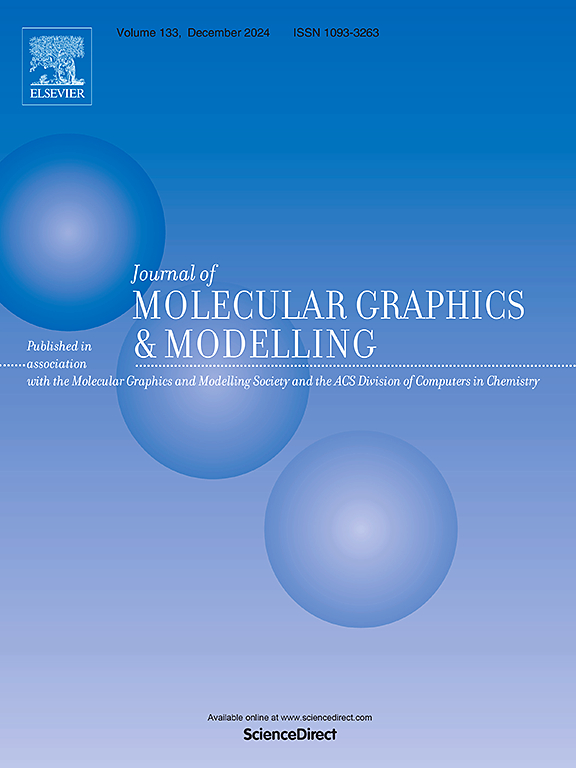基于DFT-D3的原始和锂掺杂B16N16纳米笼传感g系列神经毒剂的分子建模研究
IF 3
4区 生物学
Q2 BIOCHEMICAL RESEARCH METHODS
引用次数: 0
摘要
探测和清除有毒战剂,如g系列神经毒剂,是环境安全和公众健康研究的一个关键领域。本研究利用密度泛函理论(DFT)解决了g系列神经毒剂与氮化硼纳米笼(BNNC)和锂掺杂氮化硼纳米笼(Li-BNNC)分子水平相互作用的理解空白。所研究的纳米结构具有较高的负吸附能,使g系列神经毒剂能够在BNNC和Li-BNNC表面上进行强吸附。Li-BNNC配合物进行化学吸附,吸附能在−31.819 ~−33.635 kcal/mol之间。前沿分子轨道(FMOs)和态密度(DOS)的研究结果表明,GS@BNNC和GS@Li-BNNC的电子特性发生了显著的变化,导致能隙变小,电导率提高。li掺杂导致Li-BNNC系统中的能量缺口更小,例如Tabun@Li-BNNC的能量缺口为2.707 eV,从而导致更高的导电性。Tabun@Li-BNNC在掺锂体系中电导率最高,为4.60 × 1012; Tabun@BNNC在未掺杂的BNNC体系中电导率最高,为2.84 × 1012。Li-BNNC系统具有更高的导电性,这使其成为检测g系列神经毒剂的良好传感器。这些发现为锂掺杂对bnnc基纳米材料的影响提供了分子水平的理解,以及它们在推进纳米技术驱动的气体传感器方面的潜力。本文章由计算机程序翻译,如有差异,请以英文原文为准。

A molecular modeling study of pristine and Li-doped B16N16 nanocages for sensing G-series nerve agents using DFT-D3
The detection and removal of toxic warfare agents, such as G-series nerve agents, is a critical area of research for environmental safety and public health. This research uses density functional theory (DFT) to address the gap in understanding the molecular-level interactions of G-series nerve agents with boron nitride nanocages (BNNC) and lithium-doped boron nitride nanocages (Li-BNNC). The investigated nanostructures exhibited high negative adsorption energies, allowing the G-series nerve agents to adsorb strongly onto the BNNC and Li-BNNC surfaces. The Li-BNNC complexes undergo the chemisorption process with the adsorption energy, ranging from −31.819 kcal/mol to −33.635 kcal/mol. The findings of frontier molecular orbitals (FMOs) and density of states (DOS) indicated that the electronic characteristics of GS@BNNC and GS@Li-BNNC had been significantly changed, resulting in a smaller energy gap and higher conductivity. The Li-doping results in much lower energy gaps in Li-BNNC systems, such as 2.707 eV for Tabun@Li-BNNC, that cause higher electrical conductivity. Tabun@Li-BNNC has the highest electrical conductivity of 4.60 × 1012 among Li-doped systems, and Tabun@BNNC has a high conductivity of 2.84 × 1012 among undoped BNNC systems. Li-BNNC systems have higher electrical conductivity, which makes them good sensors for detecting G-series nerve agents. These findings provide a molecular-level understanding of the effect of Li-doping on BNNC-based nanomaterials and their potential for advancing nanotechnology-driven gas sensors.
求助全文
通过发布文献求助,成功后即可免费获取论文全文。
去求助
来源期刊

Journal of molecular graphics & modelling
生物-计算机:跨学科应用
CiteScore
5.50
自引率
6.90%
发文量
216
审稿时长
35 days
期刊介绍:
The Journal of Molecular Graphics and Modelling is devoted to the publication of papers on the uses of computers in theoretical investigations of molecular structure, function, interaction, and design. The scope of the journal includes all aspects of molecular modeling and computational chemistry, including, for instance, the study of molecular shape and properties, molecular simulations, protein and polymer engineering, drug design, materials design, structure-activity and structure-property relationships, database mining, and compound library design.
As a primary research journal, JMGM seeks to bring new knowledge to the attention of our readers. As such, submissions to the journal need to not only report results, but must draw conclusions and explore implications of the work presented. Authors are strongly encouraged to bear this in mind when preparing manuscripts. Routine applications of standard modelling approaches, providing only very limited new scientific insight, will not meet our criteria for publication. Reproducibility of reported calculations is an important issue. Wherever possible, we urge authors to enhance their papers with Supplementary Data, for example, in QSAR studies machine-readable versions of molecular datasets or in the development of new force-field parameters versions of the topology and force field parameter files. Routine applications of existing methods that do not lead to genuinely new insight will not be considered.
 求助内容:
求助内容: 应助结果提醒方式:
应助结果提醒方式:


